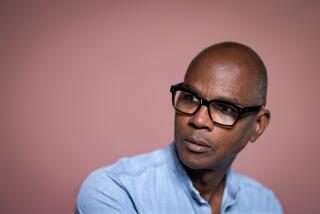CRAFT AND FOLK ART MUSEUM SHOW : TAKING LIBERTIES WITH MS. LIBERTY
- Share via
Seventy-six years before Frederick Auguste Bartholdi completed the Statue of Liberty, an unknown artist represented America in a mezzotint as an Indian princess wearing a towering feathered headdress. Flanked by two tomahawks and a rattlesnake, she rides in a chariot drawn by tigers. Opposite her sits Africa, symbolized by a similarly adorned black woman.
“Africa-America” is in the Craft and Folk Art Museum’s “Liberties With Liberty” exhibition, along with other early interpretations of America and contemporary folk art inspired by America’s official symbol of liberty.
The exhibition, assembled at the Museum of American Folk Art in New York to coincide with last year’s Liberty celebration, features an eclectic assortment of 76 works--including oil and watercolor paintings, sculpture, quilts, scrimshaw and engravings. They represent each phase in the development of the symbol and run a stylistic gamut from pristine to kitsch.
Before the Statue of Liberty’s installation in New York Harbor in 1886, America was alternately symbolized in female form as a dark-skinned, bare-breasted Indian Queen, a princess, a goddess and a woman called Columbia.
In “Liberties With Liberty,” a tacky metal-alloy replica of the statue, housing both a Christmas light and thermometer, shares museum space with a late 19th-Century weathervane and with “Centennial Progress U.S.A. July 4, 1876,” a 1987 oil by Montgomery C. Tiers, featuring a regal Liberty accompanied by a host of historical figures.
Other novelties include a 19th-Century wooden Indian princess perched on rollers, clutching a handful of cigars, and David Butler’s 1980 version of Liberty--a crude, devilish metal figure with spiky teeth and a punky, polka-dotted dress.
“The exhibit covers a period of 220 years and in that time I think things have gone full circle in terms of images and sophistication,” said Patrick Ela, the museum’s executive director, in a recent interview. “The contemporary pieces are for the most part very sophisticated; some are very funky. Some people might wonder why some pieces are included. There’s a Japanese (manufactured) ceramic cast of an ice cream cone that you could probably buy for 50 cents in New York.
“But we wanted to cover the spectrum of Pop and elite arts. I think (the exhibit) shows the universality and appeal of liberty as a theme for doing art, for making some kind of statement.”
According to Ela, artists’ representations of America became less refined once the Statue of Liberty was unveiled.
“To me, the earlier pieces seem to have a more serious symbolism--historical or literary references--especially in the paintings,” Ela said. “If anything, the symbolic importance after the Statue of Liberty was created was somewhat trivialized and taken for granted. The later pieces have more personal interpretations.
“The Statue of Liberty has so dominated our thoughts . . . it’s such a strong image, a universal symbol. And so to go beyond that is difficult. I think the Statue of Liberty was the turning point in the way people dealt with the concept because it became such a common statement.”
The statue became a favorite target among commercial and Pop artists. Ela pointed to two of greeting card artist Hudson Talbott’s pieces in the show as successful manipulations of the image. In “Apple Pie,” a humanized Liberty leans over to remove a pie from the oven as New York skyscrapers watch through her window. For “American Gothic Christmas,” Grant Wood’s stern farm couple have been transformed into a funky Uncle Sam accompanied by a stately Liberty sporting red earmuffs.
The exhibit continues at the Craft and Folk Art Museum, 5814 Wilshire Blvd., through Aug. 16.
More to Read
The biggest entertainment stories
Get our big stories about Hollywood, film, television, music, arts, culture and more right in your inbox as soon as they publish.
You may occasionally receive promotional content from the Los Angeles Times.










